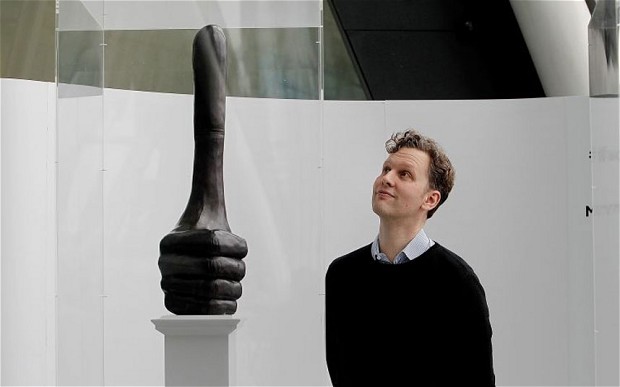David Shrigley is a visual artist and illustrator from Cheshire, now based in Glasgow where he graduated with a degree in Environmental Art in 1991. He has produced work in many differing mediums, directing music videos for Blur’s “Good Song” and Bonnie ‘Prince’ Agnes’ “Queen of Sorrow” and in 2013 Shrigley was nominated for the Turner prize for his really good “Really Good” sculpture which is to be installed on Trafalgar Square’s fourth plinth in 2016. Shrigley’s work is easily identifiable for its dark, dry comedy and this most often takes on the form of crude hand drawn illustrations which are simplistic and produced on mass, appearing in large collections as a surreal stream of conscious, like a modern day beat illustrator but in place of starry eyed romanticism instead a grounding in everyday feeling and fears takes its place.
“As an artist you have to feel your art makes the world a better place and you have to believe that quite sincerely, otherwise why would you make it?”
Shrigleys work is bold and designed to invoke a personal reaction within a viewer, these reactions tread a fine line between laughs and more serious contemplation. There’s something distinctly british and satirical to his work, particularly in the text that accompanies the bulk of his illustration, often captioning or working with images in interesting, witty or conflicting ways.
“I only do anything once. That’s the rules.”
Shrigley’s working methods have an interesting sense of permanence for what are often fleeting feelings or statements. He uses black ink and brush or water based marker pens and produces high volumes of work refusing to redraw any of his work, his mistakes and crossings out becoming a part of the work itself. Shrigley’s entire methodology seems to be centred around feelings of varying specificity and how to thoroughly communicate them. Frankly speaking Shrigley’s drawings being more technically proficient or time consuming would serve no purpose as the blunt force of his roughshod black-on-white line drawings communicates his soundbite mantras perfectly.
“Another method is to write a list of things to draw before I start: a tree, an elephant, a lorry, an orgy etc. This gives each drawing a starting point. Once I have started, the drawing usually manages to get somewhere. I think the starting point is important for an artist. Once you’ve started the battle is half won.”
David Shrigley @ OFFSET 2009:
Shrigley is part of/partly responsible for the massive resurgence in hand drawn elements of popular illustration. In an art form becoming increasingly overwhelmed by technological advances, where any mistake or imperfection can be rubbed out and remade and text is completely uniform; it is refreshing to see Shrigley’s uneven handwriting spilling out his trademark gallows humour. There’s an interesting connection between the distinctly human funny (ha-ha & odd) situations he create and the imperfect and human way he realises them.
I gravitate toward artists that a distinct personality and voice and reject the occasionally aloof and detached attitudes that seem to permeate the artistic community.
“It is what it is”
Shrigley is interesting in the fact that he is a Fine artist that (this may be less true now, but was more so when he began producing work) defies the vast majority of its stereotypes. A self proclaimed “artist that can’t draw” who’s work finds itself in unpretentious paperback books rather than a gallery setting. These books are art books which transcend the idea of an “art book” defying categorization, unclear whether they should be filed under the “art,” “humour” or “Initially funny until you realize the statement is quite profound and it begins to fill you with an impending sense of dread” sections of Waterstones.
“I don’t think I’ve ever made any conscious decision to be a comic artist, but to me there’s something quite anarchic about comedy.”
(The Guardian) Q. What do you consider your greatest achievement?
(D. Shrigley) A. Not having a proper job.
In a way, Shrigley’s penchant for work often dubbed//written off as comic art affords his ultra-dark comments (like the one above) even more weight. His work slithers into your concious under the guise of something silly and unthreatening then states something really quite earnest and it jolts you somewhat. my personal favourite piece of Shrigley’s work however does none of these things, but perfectly illustrates how I think all people feel when listening to Kate bush:
“I went from being the best artist in my class when I was six to being the worst at art when I was at art school—the worst at drawing, I should say. My objective drawing skills, relatively speaking, were not that hot compared to other art students. But I think drawing formally from life was just sort of a blip for me; I did that for a while because you have to do it when you study art, but I never quite figured out how I could express myself that way in terms of making what I wanted to make. So then I just went back to drawing the same way that I’ve always drawn ever since I was a little kid, albeit the subject matter changed over the years.”
I think this is the reason I enjoy Shrigley as an artist and an individual. I identify with the above statement. I lack some of the fundamental drawing skills i see being used by my peers and it used to be a real point of insecurity for me, but practitioners like Shrigley totally turned that on its head and i started to see that there is a spectrum of ways to visually communicate that don’t adhere to traditional practises which resulted on me feeling at less of a disadvantage and more confident in my own decisions.

























